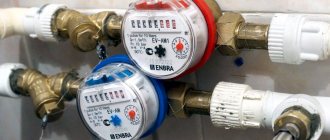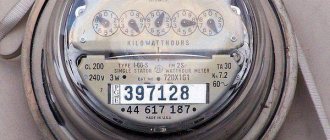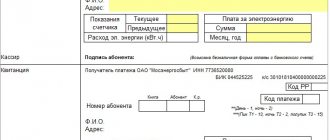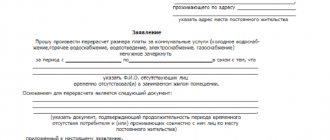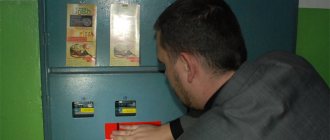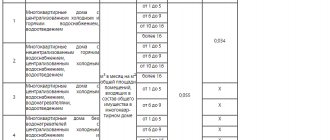The annual increase in electricity prices raises many questions among residents of apartment buildings. To answer them, the management organization, being the provider of the utility service for energy supply, must know about the groups of tariffs and their components that affect price increases. Let's talk about this today.
Concluding an energy supply agreement based on the one-stop-shop principle
72000
Who sets tariffs for the population
The amount of electricity consumed is measured in kilowatt-hours or kWh. One kWh is the amount of energy consumed by a one-kilowatt (1000 W) device in one hour. For example, a boiler with a power of 3500 W (3.5 kW) consumes 3.5 kW*h per hour of operation, and 7 kW*h in two hours.
The cost of 1 kilowatt-hour is called a tariff. It is formed in accordance with the “Methodological guidelines for calculating regulated tariffs and prices for electric (heat) energy in the retail (consumer) market”, approved by order of the Federal Tariff Service of the Russian Federation dated August 6, 2004 No. 20-e/2.
The price of 1 kWh for an individual resource consumer depends on the tariff group to which it belongs. According to clause 1.1 of Order No. 303-e of the Federal Tariff Service of the Russian Federation dated June 24, 2011, owners of residential premises in apartment buildings and providers of utility services are included in the group “population and equivalent categories” (tariff for the population).
Consumers in this group spend electrical energy for household needs, and not to make a profit. Based on the price of a kilowatt-hour for the population, the payment for the resource consumed for the maintenance of the common property of the owners of apartment buildings is also calculated.
Some non-residential premises also belong to the “population” group - these are premises of a domestic nature, for example, private garages, bathhouses, sheds and cellars. It does not matter who the owner of the non-residential premises is - an individual or a legal entity.
Non-residential premises that are used for commercial purposes (pharmacies, offices, shops, salons, etc.) are included in the tariff group “other consumers” (Article 27, Section VI of the Appendix to Order No. 20-e/2 of the Federal Tariff Service of the Russian Federation). Prices for “other consumers” differ markedly from the cost of a kilowatt-hour for the population.
Tariffs for the population, according to Art. Section 2 I Appendix to the order of the FTS of the Russian Federation No. 20-e/2, establishes the local executive authority in the field of state regulation of tariffs. For example, the Committee on Prices and Tariffs or the Regional Energy Commission. When determining the cost of a kilowatt-hour for the next calendar year, the tariff commission cannot go beyond the range established for each region by the Federal Antimonopoly Service of the Russian Federation.
Grounds for early revision of utility tariffs
128380
Advantages and disadvantages
If a two-zone meter is used in an apartment, this gives the owners the following advantages:
- When using water heating using electrical appliances, it becomes possible to save on electricity costs, doing this at a time when the cost of the resource is lower.
- If heating based on the use of electricity is used, electricity can be used, taking into account the price of it at a certain time.
- The use of a washing machine or other energy-consuming appliances can be rescheduled to that part of the day when electricity is cheaper.
The difficult aspects of operating the meter include the following:
- The initial installation or replacement procedure is quite complex and tedious.
- In order for the meter to operate accurately, it must be tested periodically. To do this, they call a technician, who comes with his own diagnostic device and performs testing. In some cases, he may insist on dismantling for the purpose of in-depth inspection of the equipment performed in his organization.
In the latter case, removal of the device is permissible only if another meter is installed in the electricity consumer's place during the inspection.
Installation of the meter can only be done by a specialist
Such devices can be divided according to their operating principle. They can be induction or electronic.
Initially, only two-zone induction type meters were used. In appearance they look like a normal device. Inside it contains two induction coils - one of them is current, the other is voltage. They create an electromagnetic field that spins the disc according to the amount of electrical energy used.
Important! This type of meters is known for its reliability and durability. According to the documents, the maximum service life is 15 years. But in fact, two-zone induction-type meters are sometimes used for more than 30 years. Its disadvantage is the insufficient accuracy of recording electricity costs.
This variety has appeared recently. It does not use moving parts involved in the measurement process. The data is displayed on an electronic display. Such a device is not only capable of storing data, but can also transmit it to other devices. This is used, in particular, in the Smart Home system.
What types of electricity tariffs exist?
Clause 2 of the Decree of the Government of the Russian Federation dated December 7, 1998 No. 1444 and Art. Section 27 II Appendices to Order No. 20-e/2 of the Federal Tariff Service of the Russian Federation divide the population into two tariff subgroups:
- Rural and living in houses with stationary electric stoves.
- The rest of the population is urban and lives in houses with gas stoves.
According to clause 2 of RF PP No. 1444, when determining the price for 1 kWh for the first group of consumers, a reduction factor of 0.7 (- 30%) is applied to the tariff of the second group established by the executive authority. For example, with a price for the urban population of 3.26 rubles/kWh, the cost of a kilowatt-hour for the rural population and those living in houses with electric stoves is 2.28 rubles.
In accordance with Art. Section 7 II Appendix to the order of the FTS of the Russian Federation No. 20-e/2 the tariff can be:
- Single (single-rate).
The cost of a kilowatt-hour does not depend on the time of day - the entire volume is calculated at one price.
- Differentiated by two zones of the day (two-zone, day/night).
The volume of consumption is recorded separately from 07:00 to 23:00 (daytime), from 23:00 to 07:00 (night). The price of electricity consumed at night is significantly lower than the cost of kWh during the day.
- Differentiated by three zones of the day (peak, half-peak, night).
Consumption is taken into account separately at night (from 23:00 to 07:00), as well as during peak time (from 07:00 to 09:00, from 17:00 to 20:00) and during “half-peak” (from 09:00: 00 to 17:00, from 20:00 to 23:00 hours).
For example,
The last two types of tariffs are applied only if the consumer has a multi-tariff metering device established in accordance with Federal Law dated November 23, 2009 No. 261-FZ, Decree of the Government of the Russian Federation dated May 6, 2011 No. 354, Order of the Ministry of Industry and Trade of the Russian Federation dated January 21, 2011 No. 57, etc. .
Examples of approved tariff schedules for the population can be seen in the decrees and orders of regional executive authorities:
- Resolution of the Committee on Prices and Tariffs of the Khabarovsk Territory dated December 19, 2017 No. 38/5,
- Order of the regional energy commission of the Department of Prices and Tariffs of the Krasnodar Territory dated December 19, 2017 No. 60/2017-e,
- Order of the Ministry of Energy and Housing and Communal Services of the Samara Region dated December 14, 2017 No. 736.
Instructions: how to conclude a resource supply agreement for non-residential premises
263822
Features and Benefits
Many people use electrical appliances without thinking much about how much it will cost them. A payment system is often used in which the tariffs applied during the day do not change. In fact, there are periods of time during the day during which the price of a consumed resource decreases. However, only owners of dual-zone meters can take advantage of this
Daily power grid load
Such devices differ from conventional ones not only in that two tariffs are applied, but also in more accurate operation, although they are more expensive. When purchasing it, you can expect that the savings on electricity bills due to dual-zone tariffs will be greater than the higher purchase price.
Such counters operate in accordance with a program that switches accounting rules depending on the current time. The device records in memory information about how tariffs change, how much energy was consumed, what were the disruptions in operation and other information that is of interest.
Switching to two-tariff electricity payments reduces costs
What parts make up the tariff for the population?
Regardless of the type, the tariff for the population consists of four parts (Article 10, Section III of the Appendix to Order of the FTS of the Russian Federation No. 20-e/2). The structure is dictated by the resource supply process: electricity is a) produced, b) bought and sold, c) delivered to the end consumer, d) the whole process is regulated by infrastructure organizations.
Let's talk about each component of the tariff in more detail:
1. The cost of producing the resource.
The tariff includes the cost of a kilowatt-hour of electricity from the manufacturer (hydroelectric power station, state district power station, thermal power plant, etc.), which sells it on the wholesale market at free prices.
2. Price of electricity transmission services.
Electricity is delivered from manufacturing companies to the end consumer by network organizations. They, by right of ownership or on other legal grounds, own power grid facilities: power lines, transformer substations, distribution points, etc. (Article 3, Chapter 1 of the Federal Law of March 26, 2003 No. 35-FZ “On Electric Power Industry”).
3. Sales premium (about 5% of the total cost of 1 kWh).
Sales companies buy electricity from producers and then sell it to end consumers under energy supply contracts. Therefore, the tariff includes a sales allowance - funds that are necessary for the sales company (RSC) to operate: pay wages, create a material and technical base, maintain service offices, etc.
The size of the sales allowance is determined by the executive authority based on the calculation of economically justified expenses provided by sales companies (Section IV of the Appendix to Order No. 20-e/2 of the Federal Tariff Service of the Russian Federation).
4. Infrastructure payments (about 1% of the total cost of 1 kWh).
This is the cost of services of organizations responsible for managing the Unified Energy System of Russia and regulating the electricity market: JSC Center for Financial Settlements, JSC Trading System Administrator and JSC System Operator of the Unified Energy System, etc.
Components of the cost of 1 kWh at a price of 2.26 rubles/kWh:
Procedure for paying for electricity: is it legal to demand an advance?
962850
How is electricity calculated using an individual meter: calculator, formulas
You always have to pay for the utilities you consume according to the tariff set by the state. For apartments with an installed electric stove, the cost of electricity is slightly lower. Thanks to installed meters, users of the electricity network can pay only for the energy that they actually spent. This allows you to rationally use electrical appliances and save your family budget. The process of calculating payment for electricity by meter is quite simple, and anyone can understand it. Especially if you use our online calculator.
If you use the simplest - single-tariff - calculation system, then you only need to fill out the first three fields. With a two-tariff system - the first six. If you have a three-tariff system and the calculations take into account the half-peak tariff, then you need to fill out all the fields and then click “calculate”.
Tariffs can be found in your management company or on official regional websites.
If you don’t trust calculators or just want to figure out what the amount of payment for electricity consists of, then use the formulas given below.
Single tariff device
The simplest models of electricity meters record the consumed kilowatt-hours at one tariff. It is very easy to calculate payment for such a device. To do this, you need to record the electric meter readings to tenths and calculate the previous result from them. The resulting data is multiplied by the tariff.
Why does the electricity tariff increase every year?
To answer this question, you need to remember the components of the electricity tariff:
- The tariff includes the price for the resource from manufacturers. The rise in the cost of its production entails an increase in the cost of a kilowatt-hour for consumers.
- The deterioration of the electrical grid leads to an increase in electricity losses in the networks and requires significant investments for their repair on the part of network companies. The costs of work on electrical networks are increasing - the cost of transporting electricity, which is included in the tariff, is growing. And if the networks are not repaired, emergency power outages will occur.
Knowing the main theses of legislation in the field of tariff setting and the tariff structure, the provider of utility services for energy supply can explain to residents of apartment buildings the reasons for the increase in the price of electricity and the specifics of using one or another type of tariff in calculations.
Connection method
When a two-zone meter is installed, the connection can only be made by a specialist. Having the necessary permits: permission to work on electrical installations and having a third electrical safety group or higher.
When installing a device designed for 220 V, the connection is made to phase and zero.
Connection with single-phase voltage
The device has 4 terminals for connecting wires. Two of them are connected to external ones, and those used in the apartment depart from the rest. The presence of grounding is not a prerequisite for operation, but it is desirable that it be present.
For 380 V meters, the connection is made taking into account the presence of three voltage phases. There are three inputs for external wires and three for those from which electricity is supplied inside the house. It should be noted that if there is a three-phase voltage of 380 V, there are usually also single-phase 220 V sockets in the house.
In this case, the presence of grounding is desirable.
Connecting a three-phase device
The procedure for connecting a new meter must be properly completed. To do this you need to do the following:
- You need to contact the organization that supplies electrical energy to the house. There is a contracts department where it is necessary to re-register the current document. It is necessary to clarify which brands of meters for installation will be most preferable.
- You need to purchase a meter and ask the seller for the document required to transfer it to the company supplying electricity. It will check the two-phase meter before installation.
- An application for replacement is written and the verified meter is taken home.
After this, they call a specialist who will carry out the installation and draw up the necessary documents.

